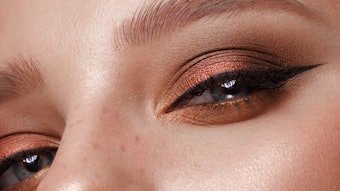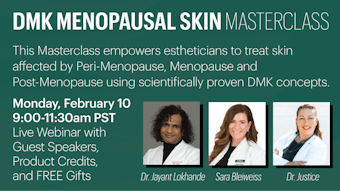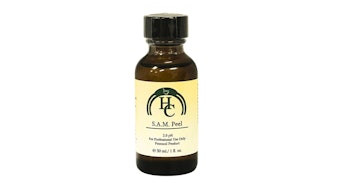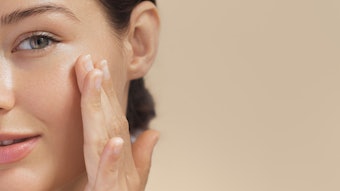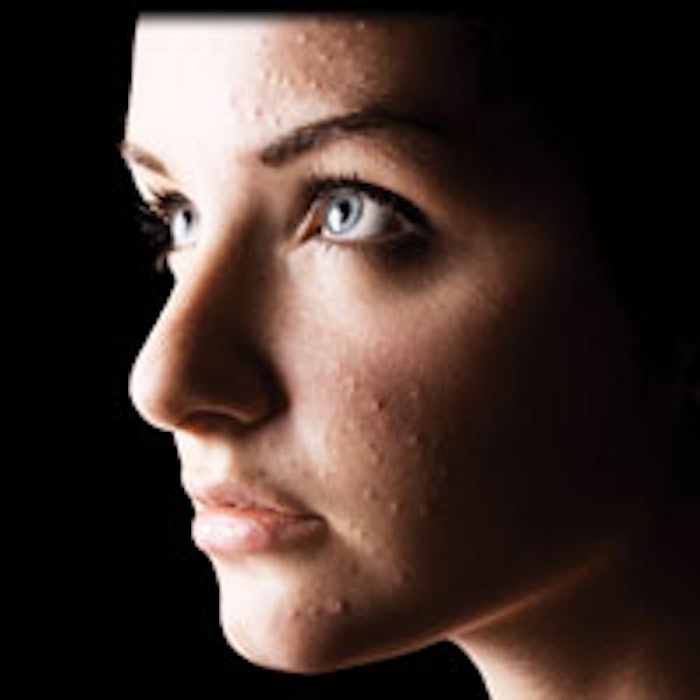
Acne is the most common skin condition, affecting virtually everyone at some point in their lives. It can be triggered by many different factors, including hormone fluctuations, irritants, illnesses and certain medications. Acne ultimately results in an overproduction of sebum, a buildup of dead skin cells and an accumulation of bacteria. Some people experience mild noninflamed acne called acne simplex, while others have inflamed acne or acne vulgaris, which is severe and can be painful. Working with clients who have acne is often a collaborative effort between physicians and skin care professionals, and marketing the results to other potential clients is crucial for the bottom line.
Physician’s point of view: Steven H. Dayan, MD, FACS
Acne can occur at any age; according to the American Academy of Dermatology (AAD), to date, nearly 40–50 million Americans suffer from some form of acne. It is important that all skin care professionals are prepared to have several treatment options available for each age group. No matter what age it occurs, there is never a good age—or a good time—for an acne breakout.
Teen acne. One of the main culprits of acne is an increase in the hormone testosterone. This is a male hormone responsible for the development of the male reproductive system and secondary male sexual characteristics, such as voice depth and facial hair. A side effect of testosterone production is that it increases oil production and the frequency of acne breakouts. Testosterone is normally produced by the testes in large quantities in men, especially during puberty. This is the reason that most teenage boys experience acne. It also occurs in smaller quantities in teenage girls, but can be just as detrimental to the skin.
Many physicians prescribe topical or oral antibiotics for teens with acne; however, there has been much excitement about the use of light-based therapies for improving acne. Laser light in the red-to-blue spectrum may be effective at killing the bacteria that cause acne, as well as decreasing inflammation.
The laser works not by heat, but by activating a protein that is released by the Propionibacterium acnes bacteria to become a killer protein that destroys the bacteria and the surrounding inflamed acne cells. The effectiveness of light-based treatments can be increased by adding a photosensitizing solution to the face, called photodynamic therapy (PDT). Lasers alone or lasers used in combination with PDT have proven highly successful and soon may be the treatment of choice for the control of moderate-to-severe acne.
Young adult acne. Many adults, because they did not experience acne during their teen years, believe that they have escaped its consequences. They are surprised, then, to find themselves at 30 or 40 experiencing burdensome breakouts. Acne seems to be less common in men after the age of 25, but for women, fluctuations in hormone levels during the menstrual cycle may cause acne breakouts. Because birth control pills cause testosterone levels to drop, many women notice that their acne breakouts are less severe when they are taking them. Spironolactone is another medication that decreases testosterone; it was originally used for medical conditions such as heart, liver and kidney disease. This medication is being prescribed more often by physicians for women that experience breakouts due to abnormal hormone levels.
With all of the other options to date, internal medications are often not patients’ first preference. A therapy often used for this age group involves applying microdroplets of Botox to the affected areas. This has shown promising results for those with overactive sebaceous glands that are not responding to traditional therapies. Those who have tried it see great relief from acne symptoms and often come back for repeated treatments.
Mature acne. Many mature patients come in to the office to treat other conditions, including photodamage and wrinkling, sagging skin. Although these may be their main points of concern, several experience breakouts as well. Many of the treatments that reduce the signs of aging are also beneficial for breakouts. Ablative laser treatments are one of those methods. Mature skin tends to have a slower cellular turnover rate, which is a main contributing factor to acne. Rapidly increasing cellular turnover will help to control breakouts while also reducing lines, wrinkles and scarring.
Esthetician’s point of view: Terri A. Wojak
Acne can be difficult to treat, and many clients have to try multiple treatment methods before they find what works for them. Because estheticians are only permitted to work on the surface of the skin, it is imperative to have a physician to refer to and consult with as needed. In cases of severe or highly inflamed acne, clients should only be treated by a medical professional. The most important role of the esthetician when dealing with acne clients is as an educator. Not only should you be educating acne clients about how they should care for their skin, but also that this is a normal condition that almost everyone experiences at some point in their lives.
Teen acne. Teenagers are affected with acne at a time in their lives when looks greatly influence their development of self-esteem. Almost all teens will experience some sort of acne during puberty. According to the AAD, more than 40% of adolescents experience acne or acne scarring, which requires treatment. For some, it may be an occasional pimple; for others, it can be so severe that it is tender to the touch and can result in scarring. One of the most important roles of the esthetician with these clients is to be sensitive to their concerns and needs.
The skin care professional’s first job, in this case, is to educate clients about how to care for their skin. Keep it as simple as possible: A typical regimen would be the use of a cleanser with a mild salicylic acid, a benzoyl peroxide spot treatment and a hydrating sunscreen. To increase results, teens can also benefit from cleansing facials with the addition of mild chemical peeling agents, including salicylic or alpha hydroxy acids (AHAs). Depending on the response to these treatments and the severity of the acne, the physician may choose to perform medical treatments as well.
Young adult acne. Many of these clients are seeking immediate treatment for a breakout because they have a job interview, an important business function or a big event on the horizon. Women at this age, in particular, often experience breakouts just before or during their menstrual cycle. For this reason, clients often schedule a cleansing facial or chemical exfoliation treatment on a monthly basis about a week before their cycle occurs to help prevent breakouts. If the acne is severe, it can be caused by more serious hormonal conditions and, therefore, should be treated by a physician. As for product recommendations, cleansers with AHAs, antioxidants, moisturizers and sunscreens are a must.
Mature acne. Although most mature skin tends to be dry, it can still break out for several of the aforementioned reasons. As cellular turnover tends to decrease, many skin conditions can occur, including acne breakouts. Most often, the best option for these clients is to introduce vitamin A products, or retinols; although, they must agree to wear sunscreen on a regular basis. Chemical peels, including modified Jessner’s peels and trichloroacetic acid (TCA) peels, are great choices for these clients. Not only will these treatments increase the cellular turnover, they will also be effective for many other conditions, including fine lines, wrinkles and hyperpigmentation.
When treating any age group with acne, it is important to do a thorough consultation. Find out what products clients are using, what they have used in the past, what worked and what didn’t. When treating those with acne, no matter what approach you are taking, it is important to make sure they are on a regular skin care program designed to meet their specific needs. Acne treatment should be a collaborative effort between the physician, the esthetician and the client.
Marketing point of view: Tracy L. Drumm
The best way to avoid a blemish on the books for your skin care facility is to create a plan to effectively engage each group within your target market. Begin by determining who you want to reach, and then tailor your message to meet the clients’ needs. Start each promotion by asking what the “what’s in it for me”(WIFM) is for potential clients. What will they gain from your treatments or products? Include the answer to this question in promotional materials for each segment of your target market.
Teens. As any parent of a teenager will tell you, to market or speak with a teenager you must simplify your message. To treat teens with acne, you have to start by fighting through the noise around them, and get their attention. Aim to create campaigns or messages that have a clear focal point with easy-to-follow instructions. Think “short and sweet” when writing copy for an age group that has grown up expressing themselves in less than 160 characters. Avoid lengthy descriptions and remember, visuals are a great tool to grab this demographic.
Skin care prescription pads are just what the esthetician ordered for this market. A small piece of paper to guide your young clients through their treatments is an easy and effective way to not only help the teens at checkout, but also to ensure their success with the products at home. This sheet of paper that resembles a prescription pad is simply the blueprint for the client’s recommended care. This young person, who is likely a first-time client, may have just invested $50–200 with your facility. It is an important part of your retention plan to set clients up for success by recommending the correct products. Easy treatment plans with three direct steps are a great starting point for teens, and remember, products such as cleansing pads that eliminate extra work will rank highly with this group.
Young adult. Progressing from teens to young adults entails a similar strategy. It involves forgetting phone calls and voice mails and, instead, getting into your clients’ inboxes. Many spas have realized a secret to speaking with and successfully marketing to young adults means making it easy for them to stay in contact with you. Look to implement ways to regularly update clients on announcements such as monthly specials, and your facility will enjoy retention numbers like never before. The key is to make it hassle-free for your team to regularly communicate and easy for your audience to quickly read your messages.
Staying active in the young adults’ calendars and budgets is as easy as speaking their language. In today’s fast-paced world, reaching clients and staying current with them often requires sending monthly service texts and e-mails to clients to confirm appointments, and reminds them when they are due for more treatments. Other outreach necessities include newsletter and birthday messaging services that allow you to announce new specials and treatments, and to reward clients with gift certificates. If this type of communication is out of your facility’s depth, there are services, such as www.solutionreach.com, that work with you to provide these opportunities to your clients.
Mature market. Your mature clients have grown up during the evolution and explosion of the beauty industry. They have likely seen and heard thousands of pitches and promises from beauty companies, and are seasoned shoppers. When speaking with this group, focus on facts that tell a story rather than trying to sell a service. Showcase not just the results the client will see from your treatments, but tell the story of what these results mean. Aspirational marketing is simply focusing on human elements, such as the quality-of-life changes clients can hope to expect after your service. Rather than simply talking about achieving clear skin, your messaging can show what clear skin really means for the lives of these clients. Whether it highlights confidence or self-respect, have your marketing efforts for the mature audience tell the story of how acne treatments improve and change the lifestyle of other clients.
Client profiles are a powerful and effective way to help tell the journey and evolution of happy clients. Start by identifying a few of your client advocates—loyal clients who regularly refer and visit you are the perfect fit. Next, partner their before-and-after pictures with a photograph they provide of themselves that exemplifies how great they feel. Women will often send in a picture of themselves on vacation, or at a party or a wedding. A picture that captures the way they feel after your treatments is the key element to feature the power of your peels or your facials. Have the client provide a testimonial, and combine all these elements to create profiles that serve as engaging methods to reach a new audience.
The key to segmenting your market is to divide and conquer. Focus your marketing efforts on the goals of each group and create campaigns that address their needs. Remember that there is no one-size-fits-all answer to growing your clientele, but tracking what works will help you thrive. Analyze which new marketing ideas truly get the phones to ring, and remember to speak with your clients on a regular basis.
Steven H. Dayan, MD, FACS, is a recognized expert in the field of facial plastic surgery and is a member of the American Academy of Facial Plastic and Reconstructive Surgery. His passion for education led him to open True University in Chicago, a training center that teaches estheticians how to appropriately work with physicians. Dayan is a 2011–2012 member of the Skin Inc. magazine editorial advisory board.
Tracy L. Drumm manages the day-to-day operations of IF Marketing, a Chicago firm specializing in aesthetic medicine. Drumm co-authored Keys to Success: Marketing & Practice Management (College of Cosmetic Medicine Press, 2007) and Thrive: Pearls to Prosper in Any Economy (College of Cosmetic Medicine Press, 2009).
Terri A. Wojak is a licensed esthetician with more than 14 years of experience. She has knowledge in all aspects of the skin care industry, including education, sales, medical esthetics, management and ownership, and she is the director, as well as an educator, at True University in Chicago. The authors can be contacted at 312-335-2070 or via e-mail at [email protected].




